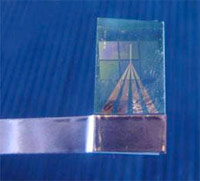Scientists have successfully utilised a virus to created a tiny battery that can power miniature electronic devices used for controlled drug delivery, and tiny lab-on-a-chip applications.
Experts at the Massachusetts Institute of Technology, Cambridge, say that their method to build microbatteries relies on a genetically-engineered virus called M13.
The scientists first made a template from polydimethylsiloxane (PDMS), a commonly used silicon-based organic polymer.
After coating it with alternating layers of positive and negative electrolytes, they added the virus.
The researchers had designed the virus to have negatively charged amino acids at its surface, so that it stuck to the template, and an affinity for cobalt, a favoured material for batteries.
Each virus is a semi-rigid fibre a few nanometres in diameter, and about a micrometre long, which tends to pack tightly into a whorl that looks similar to a fingerprint.
The researchers say that when the whole assembly is dipped into a solution of cobalt ions, it coats the viruses to create a very large surface area that could store charge.
When the researchers stamp the template onto a platinum layer, and peel off the PDMS, they get an array of small dots of the prepared material, cobalt-side down, which forms the heart of an effective battery.
This is the first time anyone has ever stamped a battery device, Nature magazine quoted Paula Hammond, part of the MIT team, as saying.
She insists that the process is an improvement on current technologies.
“Were talking about a simple, inexpensive and environmentally better way of generating a microbattery,” she says.
A research article in the journal Proceedings of the National Academy of Sciences suggests that Hammond hopes to extend the design so that the second electrode necessary for a complete battery can also be stamped using the same process.

